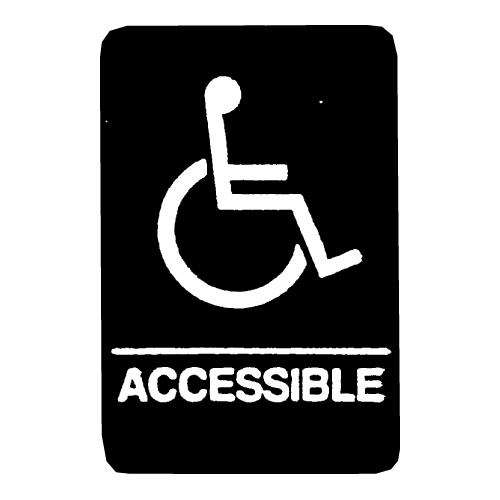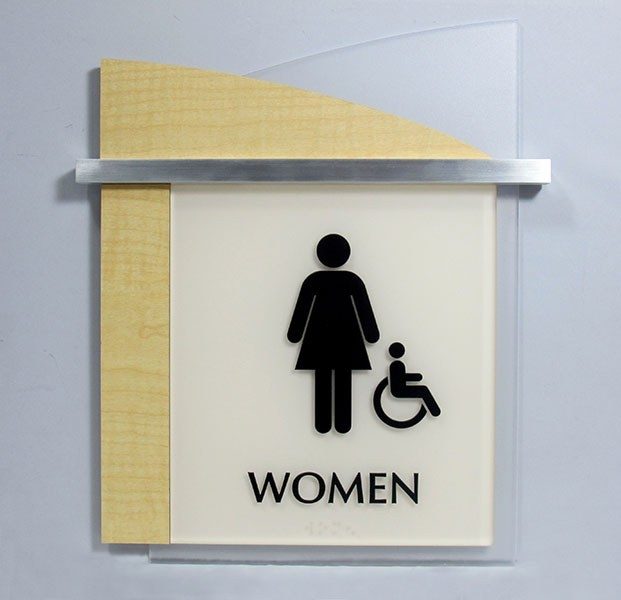The Impact of ADA Signs on Community Accessibility
The Impact of ADA Signs on Community Accessibility
Blog Article
ADA Signage: Guaranteeing Accessibility and Compliance in Public Spaces
ADA signs plays an important function in ensuring access and conformity within public areas, dramatically adding to an inclusive atmosphere for people with impairments. As we explore the nuances of ADA signs, from tactile attributes to design complexities, it's important to think about exactly how these elements integrate to promote the civil liberties of all customers.
Significance of ADA Signs
In modern-day society, the relevance of ADA signage expands past simple conformity with legal mandates to symbolize a dedication to inclusivity and ease of access for all people. These signs are vital in developing environments where individuals with impairments can browse public rooms with the very same ease and self-reliance as those without impairments. By providing clear and standard details, ADA signs makes certain that everyone can access facilities, solutions, and details without obstacles.
The significance of ADA signage exists in its capability to improve the lifestyle for individuals with specials needs by promoting equivalent gain access to. It eliminates the challenges that could otherwise impede their capacity to participate totally in neighborhood life. Furthermore, these indicators act as noticeable signs of an organization's devotion to diversity and equal rights, reflecting more comprehensive societal worths that champion the civil liberties and dignity of all people.
In addition, ADA signage plays an essential duty in public security. By guiding people to exits, toilets, and other necessary facilities, it makes sure that all people, no matter physical capacity, can evacuate securely during emergencies. In summary, ADA signs is not simply a regulatory demand yet a powerful tool for promoting a equitable and inclusive culture.
Trick Elements of Compliance

Positioning is vital; signs must be installed in locations that are obtainable and conveniently noticeable. Typically, signs should be placed in between 48 and 60 inches from the ground to make certain accessibility for both standing and wheelchair customers. Responsive elements, such as Braille, are important for individuals with aesthetic problems, supplying essential details in a non-visual layout.
High-contrast shades between the text and background are essential to boost readability for people with low vision. The ADA mandates certain contrast proportions to make sure clearness. Furthermore, character size is a key factor to consider, with minimal height demands dictated by the viewing distance to ensure readability from various angles.
Design Considerations for Accessibility
Creating available signs requires a precise strategy to ensure it satisfies the demands of all users, especially those with handicaps. The size of the text is just as crucial, with ADA guidelines suggesting a minimum elevation based on seeing distance to ensure clarity.
Contrasting shades in between text and background are necessary for visibility, particularly for individuals with aesthetic problems. A high comparison proportion helps distinguish the text from its background, improving readability under numerous lights problems. Additionally, tactile aspects, such as Braille and increased personalities, are essential for people that are blind or have low vision. These elements should be situated at a regular elevation and position to ensure easy access and comprehension.
Furthermore, the positioning of signs plays a substantial role in ease of access. Indications ought to be installed in locations that are unblocked and quickly reachable. Ensuring that signs is placed at proper elevations and angles allows all individuals, consisting of those making use of wheelchairs, to interact with them effectively.
Usual Errors to Avoid

Another widespread mistake is the incorrect positioning of signage. ADA standards specify specific height and area demands to guarantee that indicators are quickly noticeable and reachable by all individuals, consisting of those using mobility devices. Overlooking these standards not only interferes with ease of access yet likewise risks non-compliance with legal criteria.
Furthermore, not enough contrast between message and background is a constant oversight. Sufficient comparison is vital for readability, specifically for individuals with reduced vision. Developers in some cases pick colors that are visually enticing but lack the needed comparison, rendering the message difficult to determine.
Last but not least, some designers stop working to include tactile elements, such as Braille, which are critical for individuals who are blind. Leaving out these attributes not only leads to non-compliance with ADA laws but likewise limits gain access to for a section of the populace that relies upon tactile info.
Future Trends in Signage
Improvements in modern technology and increasing understanding of inclusivity are forming the future trends in signage design. As society ends up being much more mindful of diverse requirements, the combination of wise innovations right into signage is getting grip. Digital signage, for example, is progressing to consist of real-time updates and interactive features, which can be essential in offering dynamic information in public spaces. These indicators often include touch displays or gesture-based controls, making it possible for individuals to navigate content tailored to their details needs.
Another arising trend is the application of enhanced reality (AR) to This Site improve user experience. AR-enabled signs can overlay digital details onto the physical environment, giving visually damaged individuals with auditory or haptic responses. ADA Signs. This technology not just enhances accessibility yet also creates an interesting experience for all users
Sustainability is additionally a significant aspect influencing signage fads. Environment-friendly products and energy-efficient illumination remedies are being prioritized to line up with website link international environmental objectives. Moreover, improvements in products science are causing the growth of more weather-resistant and durable indications.
Conclusion
ADA signage plays an essential role in guaranteeing availability and conformity within public rooms by incorporating tactile aspects, high-contrast shades, and critical placement. The adherence to ADA requirements not just facilitates risk-free navigating for individuals with handicaps but likewise indicates an organization's commitment to variety and inclusivity. By avoiding common errors and accepting future fads, public spaces can continue to progress these worths, making certain that the rights and dignity of all individuals are navigate to this site respected and upheld.
ADA signage plays a vital duty in assuring availability and compliance within public areas, substantially contributing to an inclusive environment for people with handicaps. As we discover the subtleties of ADA signage, from tactile attributes to make details, it's vital to think about exactly how these elements coalesce to copyright the civil liberties of all individuals.In contemporary society, the value of ADA signs extends past simple compliance with lawful requireds to embody a dedication to inclusivity and ease of access for all people. By supplying clear and standard info, ADA signage ensures that every person can access facilities, services, and details without barriers.
ADA signs plays an important role in ensuring accessibility and conformity within public areas by including tactile elements, high-contrast shades, and tactical positioning. (ADA Signs)
Report this page